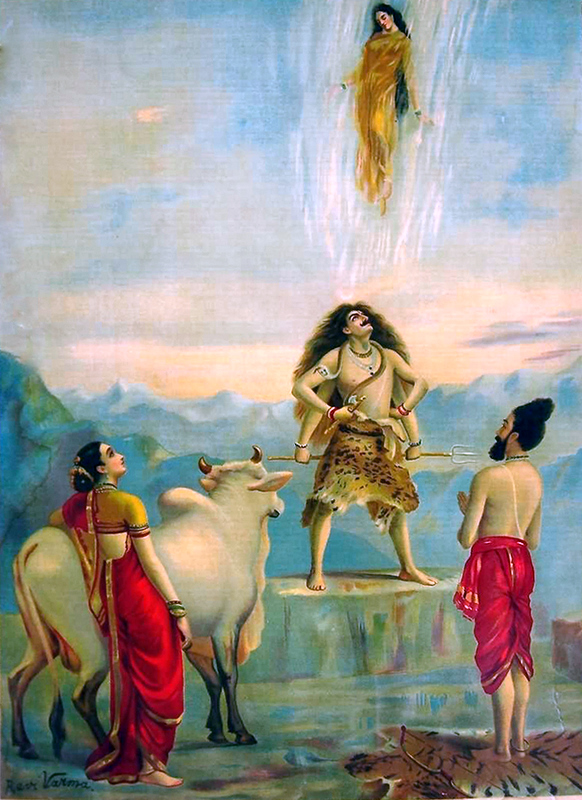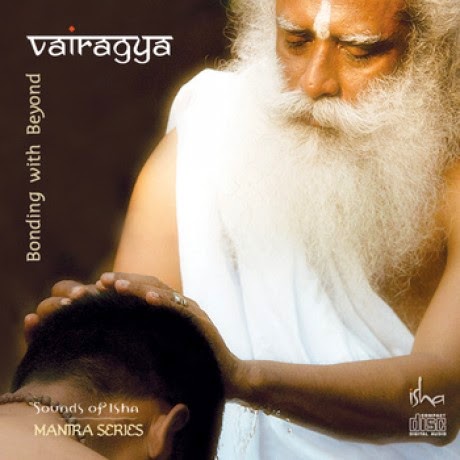Shiva spent much time in meditation to ensure that all went well with the world, that good deeds were rewarded and evil ones were avenged. One day he was deep in meditation when he became aware that King Bhagirath was calling to him. Shiva knew that King Bhagirath was a saintly man who had given up his kingdom and spent years praying to him. Shiva also knew that he would not ask for anything selfish so the god stirred from the tiger-skin on which he was sitting and descended to Earth to the place where the king sat praying.
"I am pleased with you Bhagirath," said the Lord of Creation in a melodious voice. "Do not be afraid to tell me what you want." Bhagirath fell down at Shiva's feet, crying tears of gratitude. "Lord Mahadev," he said humbly, "I cannot believe my good fortune in being honored by your presence." Then he began to tell Shiva his story.
More than a hundred thousand years ago, his ancestor King Sagar had decided to perform an important sacrifice which required a special horse to be consecrated at a ritual feast and then set free to wander wherever it wished for a year. Sagar commanded his 60,000 sons to follow the horse and, in accordance with the custom, ordered them to conquer the kings of every country the horse entered. But the princes lost sight of the horse and their angry father told them not to return home until they had found it. The princes searched all over the world and finally dug a massive gorge to the underworld: the gorge was so large that eventually it covered more than half the world and when the princes climbed down into it and entered the underworld, they found the horse grazing peacefully in a meadow. Nearby the great sage Kapila sat deep in meditation and the 60,000 princes at once accused him of stealing the sacrificial horse.
Kapila was enraged both by the accusation and by the interruption to his prayers. According to some, Kapila was the son of Agni the fire-god, and now he angrily glared at the princes and a sacred flame leaped from his eyes which instantly burned them to ashes. Many years later, a nephew of the dead princes named Anshuman discovered their remains lying beside Kapila who was still deep in meditation. Anshuman fell at Kapila's feet and begged that the remains of the princes be washed in holy water so that their souls could enter Heaven.
Kapila agreed on condition that the goddess Ganga came down to Earth to cleanse them. He prophesied that a descendant of Anshuman would be the one to make this come about and now Bhagirath had finally succeeded in invoking Shiva to ask his help.
Ganga had been born from Vishnu's toe and was an unstable creature as is the nature of water. Once, long ago, the gods had begged Shiva to sing his celestial song. Vishnu knew its stupendous force, and had decided to sit directly in front of Shiva and absorb part of the might of his song which could otherwise have caused great destruction in the universe. As Shiva's song became louder, Ganga was hypnotized by its beauty and began to rise and become fuller. She would have flooded the Heavens in her ecstasy but fortunately Vishnu was prepared and imprisoned her in a large pot before she could do any damage. Ever since then she had been annoyed with Shiva for having such an effect on her.
"I will grant your wish," Shiva told Bhagirath. "But the might of Ganga gushing down to Earth would be too immense for the land to bear. There would be earthquakes, floods and fire, and the crops would be ruined for years to come. So I will sit in the spot where she is to fall and bear the impact of her power on my head. Then, when she has landed, you can take her to the remains of your ancestors and your years of prayer to me will have been repaid."
Shiva seated himself beside Bhagirath among the Himalayan glaciers and willed Ganga to make her appearance. Ganga could not resist the power of his will but was furious at being ordered to descend from Heaven. Since she had an old score to settle with Shiva she decided that she would wash him away in her swirling currents. She cascaded down from the sky as a mighty waterfall, but Shiva was prepared for her tricks - he grew into a giant and imprisoned her in the matted locks of his hair. She flowed in and out of his hair for many years and by the time she reached Earth she was harmlessly split into seven streams.
Acting on Shiva's advice, King Bhagirath blew a loud, clear note on a horn and led the way to the great gorge where the ashes of the princes lay. The main stream followed the sound, winding in and out of many countries and villages until she finally came to the entrance to the underworld. There she flooded into the last gap which covered more than half the world and filled it to the brim, washing the remains of Bhagirath's ancestors in her holy waters. The great river is today known as the sacred River Ganga or Mother Ganga, and the great gorge was named Sagar after the king whose sons had dug it. And that is what it is still called to this day, for from that day onward, sagar came to mean "ocean".
"I am pleased with you Bhagirath," said the Lord of Creation in a melodious voice. "Do not be afraid to tell me what you want." Bhagirath fell down at Shiva's feet, crying tears of gratitude. "Lord Mahadev," he said humbly, "I cannot believe my good fortune in being honored by your presence." Then he began to tell Shiva his story.
More than a hundred thousand years ago, his ancestor King Sagar had decided to perform an important sacrifice which required a special horse to be consecrated at a ritual feast and then set free to wander wherever it wished for a year. Sagar commanded his 60,000 sons to follow the horse and, in accordance with the custom, ordered them to conquer the kings of every country the horse entered. But the princes lost sight of the horse and their angry father told them not to return home until they had found it. The princes searched all over the world and finally dug a massive gorge to the underworld: the gorge was so large that eventually it covered more than half the world and when the princes climbed down into it and entered the underworld, they found the horse grazing peacefully in a meadow. Nearby the great sage Kapila sat deep in meditation and the 60,000 princes at once accused him of stealing the sacrificial horse.
Kapila was enraged both by the accusation and by the interruption to his prayers. According to some, Kapila was the son of Agni the fire-god, and now he angrily glared at the princes and a sacred flame leaped from his eyes which instantly burned them to ashes. Many years later, a nephew of the dead princes named Anshuman discovered their remains lying beside Kapila who was still deep in meditation. Anshuman fell at Kapila's feet and begged that the remains of the princes be washed in holy water so that their souls could enter Heaven.
Kapila agreed on condition that the goddess Ganga came down to Earth to cleanse them. He prophesied that a descendant of Anshuman would be the one to make this come about and now Bhagirath had finally succeeded in invoking Shiva to ask his help.
Ganga had been born from Vishnu's toe and was an unstable creature as is the nature of water. Once, long ago, the gods had begged Shiva to sing his celestial song. Vishnu knew its stupendous force, and had decided to sit directly in front of Shiva and absorb part of the might of his song which could otherwise have caused great destruction in the universe. As Shiva's song became louder, Ganga was hypnotized by its beauty and began to rise and become fuller. She would have flooded the Heavens in her ecstasy but fortunately Vishnu was prepared and imprisoned her in a large pot before she could do any damage. Ever since then she had been annoyed with Shiva for having such an effect on her.
"I will grant your wish," Shiva told Bhagirath. "But the might of Ganga gushing down to Earth would be too immense for the land to bear. There would be earthquakes, floods and fire, and the crops would be ruined for years to come. So I will sit in the spot where she is to fall and bear the impact of her power on my head. Then, when she has landed, you can take her to the remains of your ancestors and your years of prayer to me will have been repaid."
Shiva seated himself beside Bhagirath among the Himalayan glaciers and willed Ganga to make her appearance. Ganga could not resist the power of his will but was furious at being ordered to descend from Heaven. Since she had an old score to settle with Shiva she decided that she would wash him away in her swirling currents. She cascaded down from the sky as a mighty waterfall, but Shiva was prepared for her tricks - he grew into a giant and imprisoned her in the matted locks of his hair. She flowed in and out of his hair for many years and by the time she reached Earth she was harmlessly split into seven streams.
Acting on Shiva's advice, King Bhagirath blew a loud, clear note on a horn and led the way to the great gorge where the ashes of the princes lay. The main stream followed the sound, winding in and out of many countries and villages until she finally came to the entrance to the underworld. There she flooded into the last gap which covered more than half the world and filled it to the brim, washing the remains of Bhagirath's ancestors in her holy waters. The great river is today known as the sacred River Ganga or Mother Ganga, and the great gorge was named Sagar after the king whose sons had dug it. And that is what it is still called to this day, for from that day onward, sagar came to mean "ocean".










